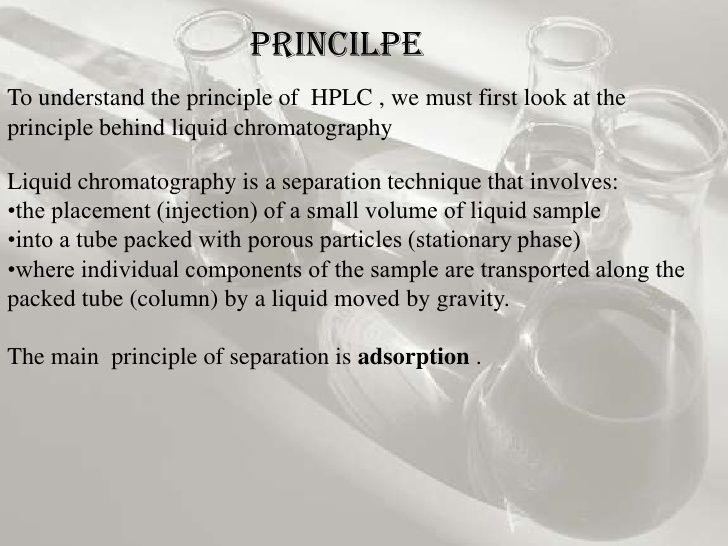But with few modifications it can be used on a wide variety of samples. Gas Chromatography Stationary Phase.

Basics Of Gas Chromatograph Gas Chromatography Gas Principles
Depending on stationary phase used in this analytical technique there are two types of gas chromatography.

. Compared to the traditional technique of gas chromatography-mass spectrometry GC-MS LC-MSMS is easier to use and is applicable for a substantially larger number of relevant analytes. Gas Chromatography - Power point presentations. Among these GLC is most.
With the development of LC-MSMS the widespread application of the proven principle of isotope dilution mass spectrometry is now feasible not only in research but also for routine applications. In this gas-liquid partition chromatography the separation of the sample mixture is carried by an inert gas with a tube. Packed - As suggested by the term it is filled with a coated inert solid support such as fire brick alumina and graphite with a specific mesh size.
A wide range of chromatographic procedures makes use of differences in size binding affinities charge and other properties to separate materials. The first analytical use of chromatography was described by James and Martin in 1952 for the use of gas chromatography for the analysis of fatty acid mixtures. In gas-solid chromatography.
Gas-liquid chromatography GLC Gas-solid chromatography GSC. To learn Principle Types Differential Extraction FAQs of Chromatography Visit. Gas chromatography is an analytical separation technique used in the separation of a mixture of volatile compounds.
Introduction to gas chromatography Gas chromatography is a chromatography technique that can separate and analyze volatile compounds in gas phase. Each detector requires gas called the detector gas based on its principle of detection. The image above shows how a gas chromatograph looks like.
The sample solution injected into the instrument enters a gas stream which transports the sample into a separation tube known as the column Helium or nitrogen is used as the so-called carrier gas The various. The stuffing of the tube is done with finely divided inert solids that are coated with non-volatile oil. Substances that have the same Rf value can be separated by using this technique.
Gas chromatography is the analytic technique used in industrial laboratories and many research for the control of the quality and the identification and quantitation of the mixture. GLPC or vapor-phase chromatography. Chromatography Principle and its Types - Chromatography may be regarded as an analytical technique employed for the purification and separation of organic and inorganic substances.
For example the flame ionization detector FID uses a hydrogen flame so it requires hydrogen and air. Basis of separation is difference in partition coefficient of volatilized compounds between liquid and gas phases when the desired compound is carried through the. Hence the name Gas-Liquid chromatography GLC This type of chromatography was primarily designed to evaluate volatile compounds like fatty acids essential oils etc.
Gas-Liquid Chromatography GLC is a separation technique in which gas usually inert gas such as helium or nonreactive gas such as nitrogen is used as a mobile phase Figure 1 and liquid as a stationary phase. Several factors such as boiling points molecular weight and relative polarity of the components of the mixture column length and the amounts of materials injected are responsible for the separation of the mixture. What happens during gas chromatography is that the components of a sample are dissolved in a solvent and vaporized to separate the analytes.
PDF Gas chromatography is a term used to describe the group of analytical separation techniques used to analyze volatile substances in the gas phase. The different types of chromatographic techniques are on the basis of the mobile and stationary phases used. Principle of gas chromatography.
The system is quite expensive cumbersome and also has delicate instrumentation. Analysis using a capillary column can also require a makeup gas added just before the detector to act as an auxiliary gas and ensure the detector receives a rapid supply of compounds. Partition Chromatography Principle.

Hplc High Performance Liquid Chromatography Liquid Molecules Gas Chromatography

Vacuum Ultraviolet Detector Vuv For Gas Chromatography Gc Gas Chromatography Vacuum Detector

Gas Chromatography Gas Chromatography Medical Laboratory Science Chemistry

Working Principle Of Gas Chromatograph Gas Chromatography Principles Chemistry

ガスクロマトグラフィー 基本原理 Youtube Data Processing Gas Chromatography Gas

Gas Chromatography Gc By Faizan Akram Gas Chromatography Gas Medical Laboratory Science

Hplc Principle Instrumentation And Application Physical And Chemical Properties Principles Gas Chromatography

Hplc High Performance Liquid Chromatography Gas Chromatography Molecules Liquid

Mass Spectrometry Ms Principle Working Instrumentation Steps Applications Instrumentation Micr Mass Spectrometry Chemical Kinetics Polymer Chemistry

The Workings Of Gas Chromatography Gas Chromatography Organic Chemistry Study Science Chemistry

Hplc Principle Instrumentation And Application Physical And Chemical Properties Principles Beakers

Working Principle Of Gas Chromatograph Gas Detector Gas Chromatography Gas

Mass Spectrometry Gas Chromatography Floor Plans

Gas Chromatography Detectors Gas Chromatography Detector Gas

Multi Column Gas Chromatograph Gas Column Multi

Chromatography Is A Technique Used To Separate And Identify The Components Of A Mixture Works By Allowing The Mo Science Chemistry Molecules Separation

Working Principle Of Gas Chromatograph Gas Chromatography Research Methods Principles

Teaching Science Chemistry Thin Layer Chromatography

